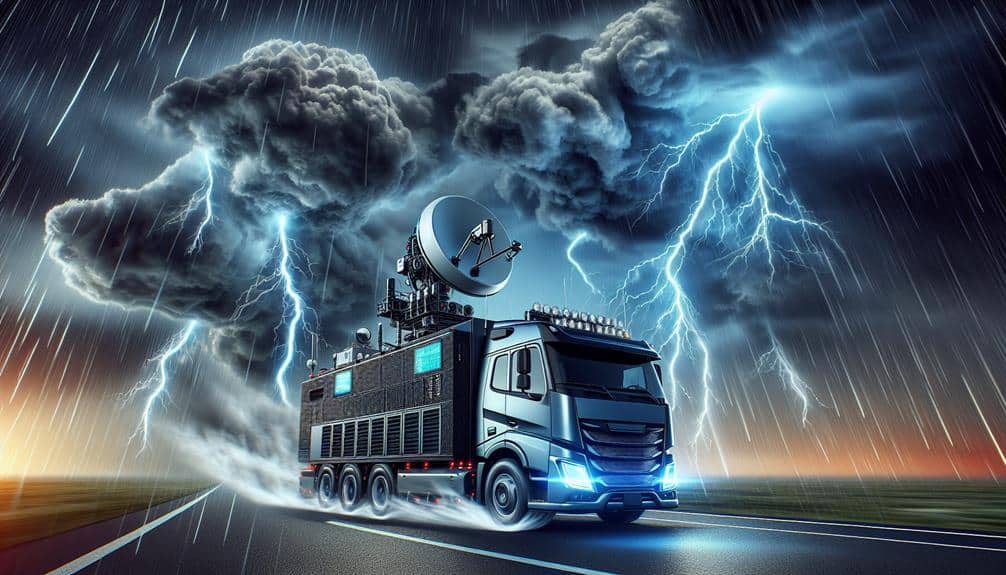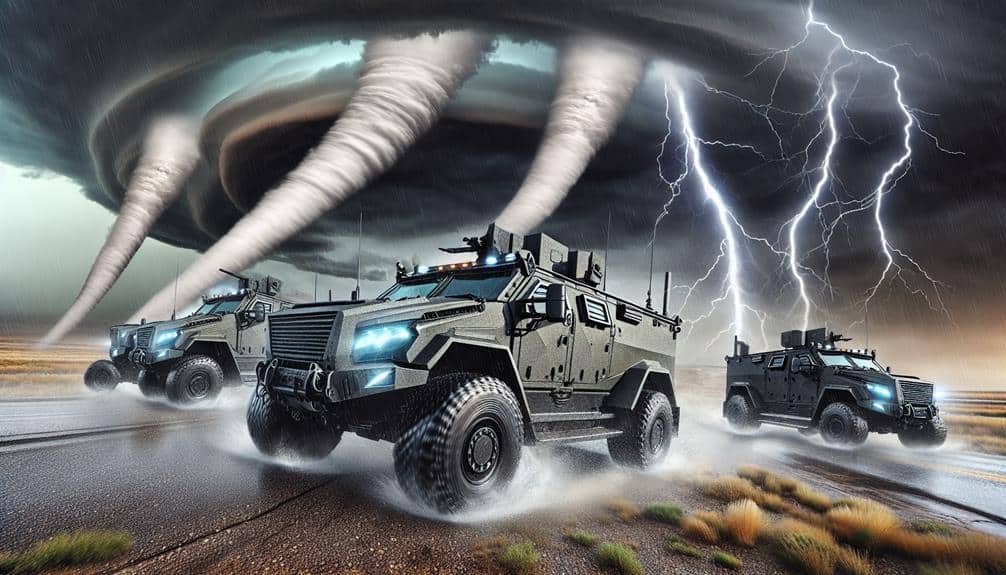When storm chasing, we need sturdy tires with strengthened sidewalls to withstand harsh conditions. They should have optimized tread designs with deep grooves and multi-directional sipes for superior water dispersion and traction control. Proper inflation is essential, so we must regularly check tire pressure with a reliable gauge to verify it meets the manufacturer's recommendations. This not only boosts performance but also enhances safety and fuel efficiency. By prioritizing durability, selecting the right tread design, and maintaining proper tire inflation, we can navigate treacherous weather with confidence. Stay tuned for more detailed insights on each of these vital aspects.
Key Points
- Invest in high-quality, durable tires with reinforced sidewalls for adverse weather conditions.
- Choose tires with deep grooves and multi-directional sipes for optimal water dispersion and traction.
- Maintain proper tire pressure using a reliable gauge to ensure safety and performance.
- Conduct routine inspections to identify and address signs of wear and tear promptly.
Prioritize Durability
When it comes to storm chasing, we can't emphasize enough the importance of prioritizing tire durability to guarantee safety and performance under extreme weather conditions. As storm chasers, we face unpredictable terrains, ranging from waterlogged roads to debris-strewn paths. It's crucial that our tires withstand these harsh environments without compromising our freedom to move swiftly and safely.
First and foremost, we need to invest in high-quality tires specifically designed for adverse weather conditions. These tires should feature reinforced sidewalls and robust construction to resist punctures and maintain their integrity under stress.
Regular tire maintenance is another critical aspect. We must routinely inspect our tires for signs of wear and tear, such as cracks, bulges, or uneven tread wear, which can jeopardize our safety during a chase.
Proper tire pressure is essential too. Underinflated or overinflated tires can greatly impair our vehicle's handling and increase the risk of blowouts. Hence, using a reliable tire pressure gauge and adhering to the manufacturer's recommended pressure levels is non-negotiable.
Optimize Tread Design
Optimizing tread design is fundamental for maximizing traction and control on the unpredictable and often hazardous surfaces we encounter during storm chasing. When we're out there, every second counts, and having the right tread can make all the difference between a safe encounter and a risky misstep.
First, let's talk about water dispersion. Effective tread designs feature deep grooves and channels that help channel water away from the tire's contact patch. This minimizes hydroplaning and guarantees that our tires maintain consistent contact with the road, even in heavy rain. The faster we can disperse water, the more control we've over our vehicle, necessary when maneuvering through torrential downpours.
Traction control is another vital aspect. High-performance storm chasing tires often incorporate multi-directional sipes and varied tread block patterns to enhance grip on a variety of surfaces, from slick asphalt to muddy rural roads. These designs provide the flexibility needed to handle quick maneuvers and sudden stops, allowing us to adapt swiftly to changing conditions.
In short, carefully optimizing our tire tread design is a key element in achieving the freedom we crave while ensuring we stay safe and in control, regardless of what Mother Nature throws our way.
Ensure Proper Inflation
Maintaining proper tire inflation is essential for maximizing our vehicle's performance and guaranteeing our safety during storm chasing missions. When we're out in the field, tire pressure isn't just a number; it's a lifeline.
Under-inflated tires can lead to poor handling and increased stopping distances, while over-inflated tires can make our ride harsh and reduce traction. Both scenarios can compromise our ability to navigate hazardous weather conditions effectively.
Let's break it down: checking tire pressure should be an integral part of our pre-chase routine. We need to use a reliable tire pressure gauge to guarantee our tires are inflated to the manufacturer's recommended levels, which can usually be found on a sticker inside the driver's door or in the owner's manual.
Regular checks are essential, especially given how temperature fluctuations can affect tire pressure.
Safety precautions are crucial. We should inspect our tires for any signs of damage or wear and address these issues before they escalate. Properly inflated tires not only enhance our vehicle's stability but also improve fuel efficiency, which is vital when we're covering long distances.
Frequently Asked Questions
What Safety Gear Should You Carry While Storm Chasing?
When storm chasing, we can't forget our emergency supplies and communication devices. Imagine the thrill, but safety first: pack protective clothing, a first aid kit, and reliable communication tools. Our freedom depends on our preparedness.
How Do Weather Conditions Affect Tire Performance During Storm Chasing?
Weather conditions significantly impact tire performance. We need ideal tire pressure and sufficient tread depth to maintain grip on wet or slick roads. Properly maintaining these factors guarantees we can chase storms safely and efficiently.
What Vehicle Types Are Best Suited for Storm Chasing?
We prefer vehicles with off-road capabilities and moderate size for storm chasing. They offer agility and durability. SUVs and trucks strike a balance between maneuverability and robustness, essential for tackling unpredictable terrains and weather conditions.
How Often Should You Replace Your Storm Chasing Tires?
We should replace our storm chasing tires every 20,000 to 25,000 miles. Regular tire maintenance is important for safety and performance. Monitoring tread wear and overall tire lifespan guarantees we're always ready for the next chase.
Are There Specific Brands Recommended for Storm Chasing Tires?
Who doesn't love a thrill? For storm chasing, we recommend brands like BF Goodrich and Goodyear. They offer budget-friendly options and superior off-road capabilities, ensuring we stay safe and agile while pursuing nature's fiercest displays.

